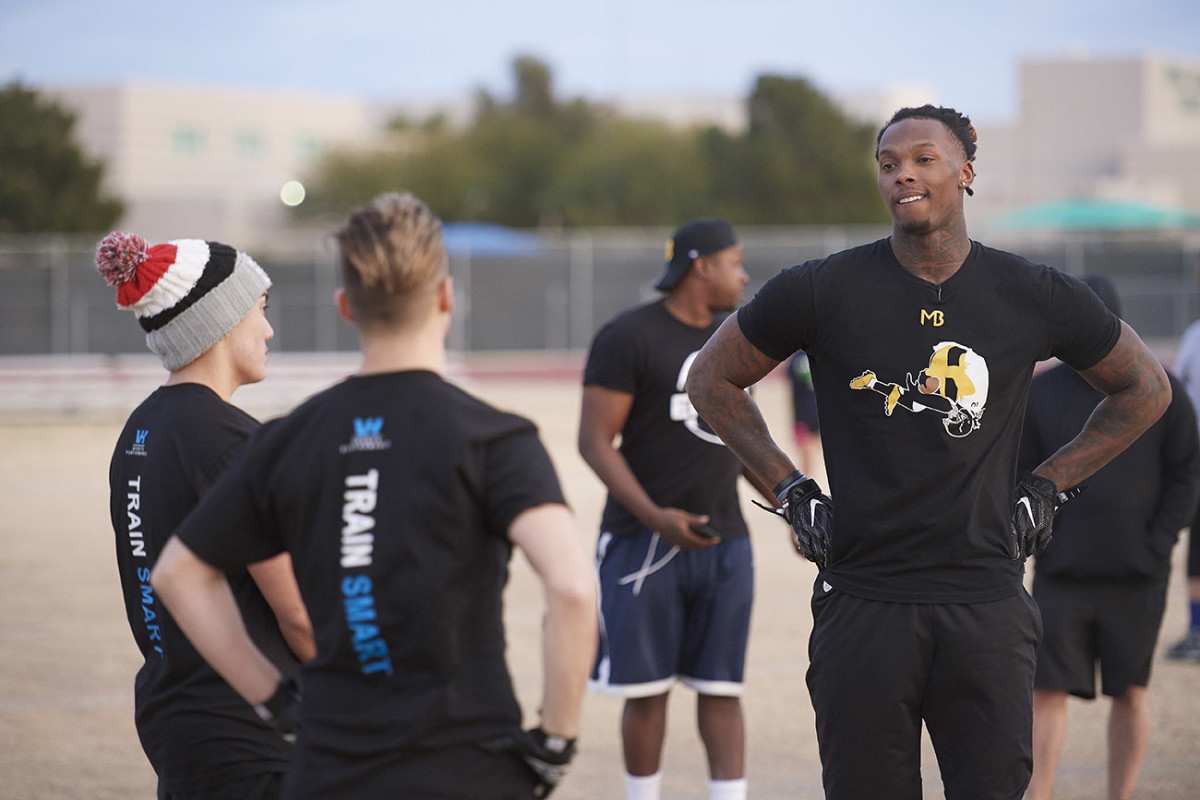Martavis Bryant Will Take the Steelers to the Super Bowl. Or Spoil Their Season. Again.

One morning during the Steelers’ 2015 training camp, Martavis Bryant went missing. Before a string of failed drug tests endangered his career, the second-year receiver was already in trouble. “Where is he?” coaches asked QB Tajh Boyd, a camp invitee who’d thrown to Bryant at Clemson. “I don’t know,” Boyd responded. “Martavis is his own man.”
When Bryant finally showed up—he says he overslept—he was greeted with what was becoming the usual punishment. Offensive coordinator Todd Haley issued a few stern words, 68-year-old wideouts coach Richard Mann produced another dressing down and head coach Mike Tomlin cut to the chase: Now you owe me some money.
Tomlin kept an eye on his debtor all afternoon, which meant he was watching when Ben Roethlisberger unleashed a deep ball—presumably too deep given the curse word Big Ben let fly as it left his hand. But there was Bryant, showing off his 4.4 speed, 6' 4" frame and 79-inch wingspan, diving to catch a pass that even Boyd thought was out of the receiver’s reach. Said Tomlin, “That’s why we need him, right there.”

Within a month the NFL would slap Bryant with his first suspension, banning him four weeks for repeated failed drug tests. (Bryant says it was marijuana; the NFL doesn’t comment on drug tests.) When Bryant returned with a two-TD performance against the Cardinals in Week 6, Haley hunted him down on the sideline. “I’ve never seen anybody with what you have,” he said. “I’ve been with [Larry Fitzgerald], and God gave you something different. Don’t f--- it up.” Haley then leaned in to hug Bryant, who over the years has grown used to being alternately berated and embraced by his coaches.
“That’s what I admire about him,” says Corey Crawford, a teammate at Clemson and at Hargrave Military Academy in Chatham, Va. “He plays [his life] like a game. You mess up in a game, and the next time you get an opportunity, you do something with it. He messes up, he comes back stronger.” Few have been stronger through the first 21 games of their NFL careers: Bryant scored more TDs (14) in that span than did Julio Jones or A.J. Green (both 13), and he had more receiving yards (1,314) than Dez Bryant (1,146) or Calvin Johnson (1,287). The last time he played, in a divisional-round loss to the Broncos in 2016, he had a career-high 194 yards from scrimmage, leading CBS’s Phil Simms to compare Bryant with Randy Moss. Alas, two months after the Denver game, he was suspended again, this time for a minimum of one year, for skipping multiple tests.
When agent Tom Santanello called to deliver that news, a weary Bryant said he was done with football. Santanello reminded his client of his potential. “You’re too f------ good to quit.”
Fine, Bryant agreed. Then he called his mom.
The Reprogramming of Cam Newton
Roberta Bryant worked in a textile factory in Pendleton, S.C., for nearly 30 years. When Martavis’s high school closed down, after his sophomore year, Roberta moved the family one hour north so that her only child could play at T.L. Hanna High. The inconvenience was worth it, she figured, if football could keep him out of trouble. But it didn’t.
At Clemson, following a year at Hargrave to earn a needed math credit, Bryant was given so many sprints—and completed them so effortlessly—that coaches devised a new, more sadistic method of punishment called pencil rolls, in which he would have to lie down and roll from sideline to sideline. And still. . . . He was suspended from the 2012 Chick-fil-A Bowl for what Clemson called “academic reasons.”
Character concerns contributed to Bryant’s slide to No. 118 in the 2014 draft, and he justified all of those doubts at his first OTAs. The 22-year-old rookie knew nothing about the NFL’s drug program until he received a note on his locker after one of those first practices: He would be tested sometime within the next four hours. Bryant says he had marijuana in his system, and he failed. And still. . . . He didn’t stop. “I smoked because I was able to,” he says. As for the drug program, “I never really paid it no mind.” He kept failing tests, earning himself two fines and then the four-game suspension.
Bryant spent most of that time at a Houston rehab and workout facility run by John Lucas, a former cocaine addict and the No. 1 pick in the 1976 NBA draft. He turned in his cellphone and committed himself from 6:30 a.m. until 9 p.m. every day. In workouts he snapped resistance bands; on the field he asked for a QB who could throw harder. “I’ve had some great athletes,” Lucas says, “but Martavis might be at the top.”

When Bryant eventually checked out, he says he stayed clean for a few weeks. But Lucas wasn’t shocked to hear six months later that his client had been suspended again. Sobriety is one thing in a controlled environment, he says, “but then life gets back on you and you deal with those emotions the same way you used to. You medicate.”
Those around Bryant offer several different explanations for his continued marijuana usage. Some blame friends and hangers-on from his small hometown. Others point to new acquaintances he picked up when he settled into a rental home in Hermosa Beach, Calif., after the 2014 draft. One teammate suggests it’s his way of dealing with the NFL’s overwhelming pressures. There’s also the claim by Bryant’s former agent—denied by the receiver—that he suffered from depression. Bryant’s explanation is simpler. “I was young and dumb.”
But one theory bothers him more than the rest: that his disobedience resulted from poor parenting. When Bryant first heard about his yearlong ban, he worried what his mother might read if he didn’t break the news to her first. On the phone Roberta started crying. She feared her son would never stop smoking. “Think of your two daughters,” she pleaded, begging him to learn from his mistakes. “What are you going to do?” she asked over and over. “What are you going to do?”
Jimmy Garoppolo: ‘Eager to Play . . . I Want to Be a Starter’
Bryant took a deep breath. Then another. It was last January, and he was four months away from being conditionally reinstated. As “Canadian Goose” by Lil Uzi Vert blared over the speakers, he started tapping his fingers to the beat on a pair of 15-pound weights as his trainer, Brian Van Hook, lugged over a pair of 20s for another set of lateral raises. “We going heavier?” Bryant asked.
“Yeah,” Van Hook responded, “give me six to eight.”
The receiver unleashed a snarl midway through rep four. He stopped after six. “Can someone get me a Gatorade?”
Bryant is still learning. “My first year, I went to L.A. in the off-season and I [worked out] that first week,” he says. “Then there wasn’t any more [weight] training. The whole gym thing didn’t stick.” In 2015 he’d entered camp at a lithe 205 pounds. In ’16, at Santanello’s behest, he showed up at Van Hook’s Las Vegas gym unable to complete a full workout without vomiting. He could do only two pushups. A year later he was running 100‑yard sprints in 102° weather and doing pull-up sets with 35 pounds of weights strapped to him. He expected to return to the Steelers’ camp in Latrobe, Pa., last week weighing close to 225 pounds.
That was one change.
Bryant says he vividly remembers when he stopped smoking marijuana a year ago, how the withdrawal kept him up all night. “I would get frustrated,” he says. “I’d yell, ‘Why can’t I sleep!?’ ” Bryant says he came to understand why the best players are often the ones who are the least accessible, and so he ditched his pad in Hermosa Beach and abandoned the friends that came with it. He resettled in Henderson, Nev., 20 minutes from the Las Vegas strip, which he largely avoids. “It feels really quiet here,” he says. Plus, there’s ample space to explore on his black-and-red Raptor 700R ATV when he needs to clear his mind.
Sometimes he goes to nearby Green Valley High, where he began working with the team’s receivers last summer. Bryant talked to them about reading defenses and demonstrated how to get off the line of scrimmage. He counseled players on picking a college and dealing with girls. He even offered up his own jewelry to one player if he scored three TDs in a game.

And then there were the days spent at league-mandated drug counseling in Vegas, where he listened to the stories of fellow addicts and found a sense of perspective. “Seeing other people’s situations,” he says, “I saw mine wasn’t as bad as I thought. Two people in my rehab died this year. One lady was at home using heroin and didn’t wake up—in front of her daughter.”
Bryant spent Halloween carving pumpkins with his girlfriend, Deja, and on his birthday played video games on the couch. In December, as the Steelers built toward a playoff run, he travelled to Virginia for his and Deja’s baby shower and donned a medal that declared dad to be. Then it was off to Christmas at his grandmother’s house in South Carolina, where an NFL drug tester showed up and followed Bryant to the bathroom. Just as he has up to three times a week, Bryant peed in a cup—and passed. Roberta Bryant is starting to believe again.
Others may take some convincing.
Martavis Bryant’s return to the Steelers started with tears. On May 23, the first day of OTAs (one month after reinstatement), his two-month-old son, Kalle, woke him up at 6:30 a.m. Despite a steady rain, Bryant decided to walk that morning from his apartment to the Steelers’ facility, and as he set forth, his mind shifted from his increasingly damp clothes to his teammates and how they would receive him. He was nervous.
During his suspension, several Steelers expressed disappointment in Bryant. Roethlisberger went so far as to say the wideout had lied to his face, adding that the receiver needed to “grow up.” Even owner Art Rooney II joined in, saying of Bryant, “I’m not sure at this point you can use the words ‘count on him.’ ”

Handshakes and hugs welcomed Bryant at Pittsburgh’s facility that first day back, but he knows that just being back doesn’t mean his relationships are fully repaired. There are Steelers, like lineman Ramon Foster, who saw Bryant decide not to appeal his suspension and took that as a sign that he was ready to face his demons. Now that Bryant is here—his locker, he says, went totally untouched in his absence—all he can do is stay sober and ball out, like he did during a one-on-one drill that first week at OTAs, when he got a jump on a cornerback and bolted by him for a long reception. One field away, offensive line coach Mike Munchak gushed, “That’s pretty.”
Pittsburgh needs that wow factor. During last year’s playoff loss to the Pats, the Steelers—absent a playmaker who’s scored nearly once every five touches—converted just one of three red zone trips. Says Boyd, “There’s no doubt in my mind: If Martavis was playing, the Steelers would have been in the Super Bowl.”
Bryant couldn’t bring himself to view that game; he watched very little football during his exile. Instead he’d call his mother. “I’m ready to go back,” he’d tell her. “I’ll be glad when you go back,” she’d answer. And on some of those days he’d get off the couch and grab his Raptor, riding before sunset through the Nevada hills, carving his own routes into the dunes.
